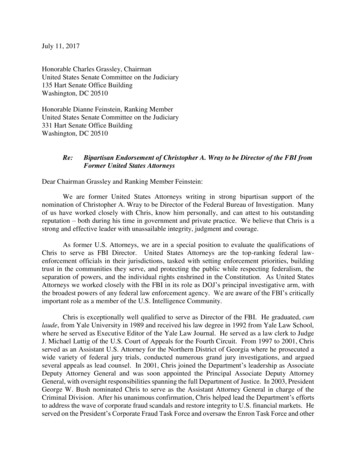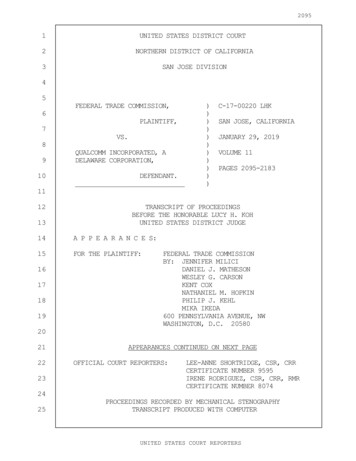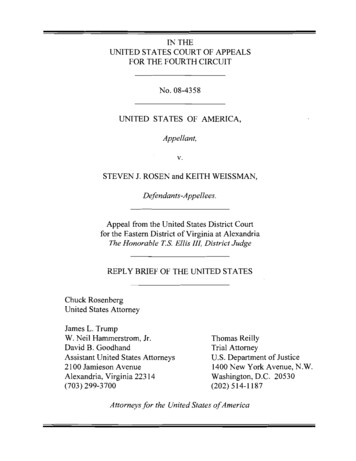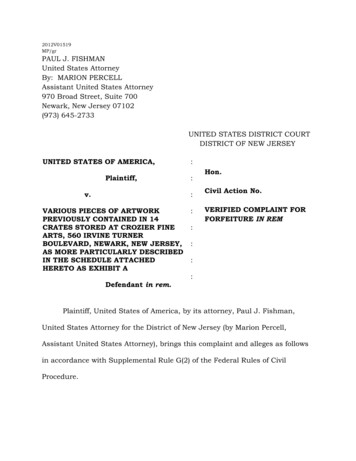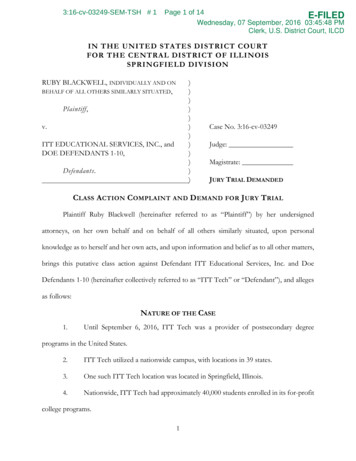
Transcription
3:16-cv-03249-SEM-TSH # 1Page 1 of 14E-FILEDWednesday, 07 September, 2016 03:45:48 PMClerk, U.S. District Court, ILCDIN THE UNITED STATES DISTRICT COURTFOR THE CENTRAL DISTRICT OF ILLINOISSPRINGFIELD DIVISION))))))))))))RUBY BLACKWELL, INDIVIDUALLY AND ONBEHALF OF ALL OTHERS SIMILARLY SITUATED,Plaintiff,v.ITT EDUCATIONAL SERVICES, INC., andDOE DEFENDANTS 1-10,Defendants.Case No. 3:16-cv-03249Judge:Magistrate:JURY TRIAL DEMANDEDC LASS A CTION C OMPLAINT AND D EMAND FOR J URY TRIALPlaintiff Ruby Blackwell (hereinafter referred to as “Plaintiff”) by her undersignedattorneys, on her own behalf and on behalf of all others similarly situated, upon personalknowledge as to herself and her own acts, and upon information and belief as to all other matters,brings this putative class action against Defendant ITT Educational Services, Inc. and DoeDefendants 1-10 (hereinafter collectively referred to as “ITT Tech” or “Defendant”), and allegesas follows:NATURE OF THE CASE1.Until September 6, 2016, ITT Tech was a provider of postsecondary degreeprograms in the United States.2.ITT Tech utilized a nationwide campus, with locations in 39 states.3.One such ITT Tech location was located in Springfield, Illinois.4.Nationwide, ITT Tech had approximately 40,000 students enrolled in its for-profitcollege programs.1
3:16-cv-03249-SEM-TSH # 15.Page 2 of 14Nationwide, as of December 31, 2015, ITT Tech had approximately 4,100 full-timeemployees.6.Upon information and belief, the number of full time employees remainedsubstantially the same, until September 6, 2016, when ITT Tech terminated the vast majority ofits employees – estimated at 8,000 – including over 4,000 full-time employees.7.The now-former employees of ITT Tech were not given 60 days’ notice of theiremployment loss or the nationwide shuttering of ITT Tech.8.As a result, Plaintiff brings this putative class action under the Worker Adjustmentand Retraining Notification Act (the “WARN Act”), 29 U.S.C. § 2101 et seq., to recover unpaidwages owed to herself and to all others similarly situated due to ITT Tech’s acts.THE PARTIES9.Plaintiff Ruby Blackwell is an individual citizen of the State of Illinois. Ms.Blackwell resides in Springfield, Illinois.10.Defendant ITT Educational Services, Inc. is a Delaware Corporation with limitedpartnership with its principal place of business at 13000 North Meridian Street, Carmel, Indiana46032, and may be served through its registered agent, The Corporation Trust Company,Corporation Trust Center, 1209 Orange Street, Wilmington, Delaware, 19801.11.Doe Defendants 1-10 may include other related entities that are currently unknownto Plaintiffs who should be named in this litigation and may be discovered as discovery in thislitigation progresses.JURISDICTION AND VENUE12.This Court has federal-question subject-matter jurisdiction pursuant to 29 U.S.C. §2104(a)(5) and 28 U.S.C. § 1331.2
3:16-cv-03249-SEM-TSH # 113.Page 3 of 14This Court has personal jurisdiction over ITT Tech, as ITT Tech is activelyengaged in the management and operation of its for-profit colleges in this State, including the ITTTech campus located in Springfield, Illinois, in addition to, upon information and belief, otheractive, regular, and systematic business conducted in this District.14.Venue is proper in this District pursuant to 28 U.S.C. § 1391 and in the SpringfieldDivision because a substantial part of the events or omissions giving rise to Plaintiff’s claims arealleged to have occurred in Sangamon County, Illinois.FACTUAL ALLEGATIONSITT T ECH ’S F OR -P ROFIT C OLLEGE SCHEME15.ITT Tech was a for-profit college which offered a variety of degree programsacross its nationwide campus.16.ITT Tech marketeds its “education” to students who wanted a “hands on” learningexperience.17.ITT Tech is listed on the New York Stock Exchange under the ticker symbol18.ITT Tech has, upon information and belief, approximately 137 locations which“ESI.”make up its nationwide campus.19.ITT Tech operated these locations as a single, integrated business, with the samecorporate oversight and structure.20.ITT Tech employed more approximately 8,000 employees immediately prior to itsSeptember 6, 2016 mass termination.3
3:16-cv-03249-SEM-TSH # 1Page 4 of 14T H E DEPARTMENT OF E DUCATION ’ S OVERSIGH T AND R EGULATION OF ITT T ECH21.On or about August 19, 2014, ITT Tech was cited by the U.S. Department ofEducation (“DOE”) for its late submission of annual compliance audits and audited financialstatements.22.As a result of this financial responsibility failure, 34 C.F.R. § 668.174(a)(3), andbeginning in October 2014, the DOE permitted schools owned and operated by ITT to participatein the Title IV, HEA programs only under a Provisional Program Participation Agreement(“PPPA”) for three award years.23.As a further result of this financial responsibility failure, in August 2014, the DOEalso required ITT Tech to post an irrevocable, five-year Letter of Credit in the amount of 79,707,879.24.Since August 2014, the DOE has been actively monitoring ITT Tech’s ongoingoperations and finances. ITT Tech was obviously aware of the DOE’s monitoring, and concernsthe DOE had about ITT Tech’s operations.25.The DOE also monitored civil litigation filed against ITT Tech by federal and statelaw enforcement agencies.26.On or about April 22, 2016, the DOE received notification that ITT Techinstitutions operating under the Indianapolis, Indiana, and Spokane Valley, Washington OPEIDsreceived a Show-Cause Directive Letter (“Directive Letter”) dated April 20, 2016 from ITT Tech’saccreditor, the Accrediting Council for Independent Colleges and Schools (“ACICS”).27.ACICS directed ITT to show cause why its grants of accreditation should not bewithdrawn by suspension or otherwise conditioned.4
3:16-cv-03249-SEM-TSH # 128.Page 5 of 14On or about June 6, 2016, the DOE issued a letter to ITT, wherein the DOE bothsummarized the bases cited by ACICS in its April 20, 2016 directive and described the increasedfinancial risk to the DOE, Title IV funds, students, and taxpayers posed by potential ACICSaction.29.The DOE required ITT Tech to increase its surety from 79,707,879 to 123,646,182.30.On or about July 2016, the DOE permitted ITT to provide the increased surety inthree installments of 14,646,101 on July 20, 2016, September 30, 2016, and November 30, 2016.31.On or about August 2, 2016, ACICS held a hearing regarding the show causeimposed on ITT Tech in Indianapolis and Spokane Valley.32.On or about August 17, 2016, ACICS informed the DOE that ACICS continuedboth institution on Show Cause after ITT Tech had submitted information requested by theaccrediting agency and participated in the hearing.33.ACICS continued to question ITT Tech’s compliance with a number of ACICSaccreditation standards.34.On or about August 17, 2016 ACICS reiterated its concern about the financialstability of ITT Tech.35.ACICS also noted the below-standard student achievement outcomes reported forretention rates for eight campuses.36.On or about August 17, 2016, ACICS determined that ITT Tech was “not incompliance” and was “unlikely to become in compliance” with ACICS Accreditation Criteria.37.In accordance with this finding, ITT Tech was deemed to have failed to meet therequirements established by its accreditors, as required by its PPPA.5
3:16-cv-03249-SEM-TSH # 138.Page 6 of 14On August 25, 2016, based on the ACICS determination, and facts set out inmultiple letters sent to ITT Tech, the DOE imposed a number of conditions on ITT Tech’scontinued participation in Title IV and HEA programs.39.These conditions included: (1) an increased letter of credit/surety; (2) a change tomethod of payment requirements; (3) notification requirements for oversight or financial events;(4) additional reporting requirements; and (5) additional operational requirements.40.Each of these conditions were detailed in the DOE’s August 25, 2016 letter to ITT41.On or about August 25, 2016, the DOE made clear that “ITT’s failure to meet anyTech.of these requirements will demonstrate to the Department that ITT is incapable of meeting thefiduciary and financial responsibility standards established by the Higher Education act and theDepartment’s regulations.”42.As the above-facts show, ITT Tech’s impending failure was known to it since atleast 2014. Still, ITT Tech shielded its employees from the ever-approaching doom, until itdropped its September 6 bombshell.T H E S EPTEMBER 6, 2016 M ASS T ERMINATION43.On September 2, 2016, Plaintiff was told that the following Tuesday – September6, 2016 – was being paid as a “comp day” and that attendance was not required.44.On a conference call held on September 2, 2016, Plaintiff’s District Managerannounced that certain news was coming, without revealing the character of this news, and furthersaid that this impending news would potentially attract media attention to ITT Tech.45.Additionally, during this conference call, Plaintiff was told to check her ITT Techemail, as important news was coming.6
3:16-cv-03249-SEM-TSH # 1Page 7 of 1446.Plaintiff, as instructed, did not go to ITT Tech on September 6, 2016.47.However, on September 6, 2016, Plaintiff received an email stating that she wasbeing terminated, and another email stating that ITT Tech was closing.48.No warning of ITT Tech’s nationwide closing or the September 6, 2016termination was given by ITT Tech to Plaintiff or other ITT Tech employees prior to an emailsent on September 6, 2016 by Erica Bisch informing ITT Tech employees that they wereterminated that day.CLASS ACTION ALLEGATIONS49.Plaintiff brings this action pursuant to the WARN Act and Rules 23(a), 23(b)(2),and 23(b)(3) of the Federal Rules of Civil Procedure on behalf of herself and, upon informationand belief, approximately 4,000 employees who worked at ITT Tech across the United States whowere terminated without cause and without proper notice on or about September 6, 2016.50.The Class is referred to herein as the “Class,” unless otherwise indicated. Plaintiffreserves the right to add, amend, modify, or further define the Class, add subclasses, and/or tomove for certification of a class or classes, including subclasses, defined differently than set forthabove depending on the facts or law as discovered in this action.51.Plaintiff asserts claims against ITT Tech individually and on behalf of all Classmembers for violations of the law as set forth below.52.The members of the Class are ascertainable from objective criteria.53.If necessary to preserve the case as a class action, the Court itself can redefine theClass, create additional classes or subclasses, or both.54.The requirements of Rule 23(a) are satisfied for the Class because the members ofthe Class are so numerous and geographically dispersed that joinder of all its members is7
3:16-cv-03249-SEM-TSH # 1Page 8 of 14impracticable. Although the exact number and identity of each class member is unknown at thistime, early investigation indicates that approximately 4,000 full-time employees worked at ITTTech and, upon information and belief, the vast majority, if not all of these individuals havesuffered an employment loss. Therefore, the “numerosity” requirement of Rule 23(a)(1) is met.55.The commonality requirement of Rule 23(a)(2) is satisfied because there arequestions of law or fact common to Plaintiff and the other members of the proposed Class thatpredominate over questions affecting only individual members of the Class. Among thosecommon questions of law or fact are, but are not limited to, the following:a. whether Plaintiff and other similarly-situated individuals were employed by ITTTech;b. whether Plaintiff and other similarly-situated individuals suffered an employmentloss;c. whether ITT Tech ordered this employment loss;d. whether Plaintiff, and other similarly-situated individuals, were entitled to notice ofthe mass layoff by ITT Tech under the WARN Act;e. whether ITT Tech gave proper notice of the nationwide closing of all ITT Techcampuses under the WARN Act; andf. whether the ITT Tech is subject to any potential defenses provided for in theWARN Act.56.Plaintiff’s claims are typical of the claims of the proposed Class that she seeks torepresent, as described above, because the claims arise from the same course of conduct andactions by ITT Tech and are based on the same legal theories. Further, Plaintiff has sustained legalinjuries arising from ITT Tech’s conduct, as alleged herein, and Plaintiff seeks the same forms ofrelief for herself and the proposed Class. Therefore, the “typicality” requirement of Rule 23(a)(3)is satisfied.8
3:16-cv-03249-SEM-TSH # 157.Page 9 of 14Because her claims are typical of the proposed Class that Plaintiff seeks torepresent, Plaintiff has every incentive to pursue those claims vigorously. Plaintiff has no conflictswith, or interests antagonistic to, the proposed Class. Plaintiff, a victim of ITT Tech’s illegal andunscrupulous acts and practices, including alleged violations of the WARN Act, is committed tothe vigorous prosecution of this action, which is reflected in their retention of competent counselexperienced in complex and challenging litigation.58.Plaintiff’s counsel satisfies the requirements of Rule 23(g) to serve as counsel forthe proposed class. Plaintiff’s counsel (a) has identified and thoroughly investigated the claims setforth herein, (b) has been in the past, and is currently, involved in complex labor and employmentlitigation, including WARN Act litigation; (c) has knowledge of the applicable law and devotes asubstantial amount of practice to employment and labor law issues; and (d) is committed to thevigorous prosecution of this action. Accordingly, Plaintiff satisfies the adequacy of representationrequirements of Rule 23(a)(4).59.This action also meets the requirements of Rule 23(b)(3). Common questions oflaw or fact, including those set forth above, exist as to the claims of all members of the proposedClass and predominate over questions affecting only individual class members, and a class actionis the superior method – if not the only method – for the fair and efficient adjudication of thiscontroversy.60.Class treatment will permit large numbers of similarly-situated ex-employees toprosecute their respective claims in a single forum simultaneously, efficiently, and without theunnecessary duplication of evidence, effort, and expense that numerous individual actions wouldproduce. Further, by prosecuting this case as a class action class members who may be (or already9
3:16-cv-03249-SEM-TSH # 1Page 10 of 14are) afraid of retaliation by ITT Tech may receive just compensation for ITT Tech’s violations ofthe WARN Act without fear of retaliation for seeking a just recovery.61.Further, notice may be provided to members of the proposed class by first-classmail to addresses maintained for each Class member by ITT Tech, and through alternative means,including electronic mail (email), social network posting (i.e., Facebook posts), and communitypostings.CLAIM FOR RELIEFCOUNT I – ON BEHALF OF THE CLASSFAILURE TO GIVE NOTICE PURSUANT TO THE WARN ACT62.Plaintiff incorporates by reference the allegations set forth in all proceedingparagraphs of this Class Action Complaint as if fully set forth herein.63.ITT Tech is a business enterprise subject to the provisions of the WARN Act, 29U.S.C. § 2101 et seq., as an “employer” because ITT Tech employs 100 or more employees,excluding part-time employees.64.Upon information and belief, ITT Tech employed approximately 4000 full-timeemployees immediately prior to the September 6, 2016 nationwide termination of substantially allITT Tech employees.65.Defendants are engaged in interstate commerce and its employees, including ITTTech staff and administration, are engaged in interstate commerce.66.The WARN Act, 29 U.S.C. § 2102 establishes that “[a]n employer shall not order aplant closing or mass layoff until the end of a 60-day period after the employer serves writtennotice of such an order to each representative of the affected employees as of the time of thenotice or, if there is no such representative at that time, to each affected employee.”10
3:16-cv-03249-SEM-TSH # 167.Page 11 of 14Further, the term “affected employees” is defined by 29 U.S.C. §2101(a)(5)“employees who may reasonably be expected to experience an employment loss as a consequenceof a proposed plant closing or mass layoff by their employer.”68.Plaintiff and Class members are “affected employees.”69.Thus, ITT Tech should have given Plaintiff and Class members 60-days’ notice ofITT Tech’s closing.70.No exception to the WARN Act is applicable here.71.The actions taken by the Department of Education, as discussed above, were notunforeseen, and did not require the nationwide closure of ITT Tech.72.Instead, ITT Tech had years of notice that the DOE and ACICS were unhappywith ITT Tech’s actions and performance.73.ITT Tech knew or should have known that failing to comply and/or participate inan ACICS Show-Cause proceeding would materially hinder ITT Tech’s ability to do business.74.Further, upon information and belief, ITT Tech made the choice not to complywith the new DOE and/or ACICS conditions, and to simply close its doors (potentially out ofspite), regardless of the negative effects on students and staff.75.Defendants did not act in good faith or with reasonable grounds for believing thattheir actions were not a violation of the WARN Act.76.Upon information and belief, ITT Tech chose to close its business, a truly unusualnationwide campus, including the termination of an estimated 8,000 employees, without propernotice, instead of continuing operation with a revised irrevocable letter of credit and a few otherDOE and/or ACICS conditions.11
3:16-cv-03249-SEM-TSH # 177.Page 12 of 14ITT Tech failed to give adequate reasons, under the WARN Act, as to why the itsentire business was closing.78.Accordingly, Plaintiff is authorized to bring this action against ITT Tech for itsviolation of the WARN Act pursuant to 29 U.S.C. § 2104(a)(1).79.Plaintiff and Class members are entitled to back pay for each day of ITT Tech’sviolation at a rate of compensation not less than the higher of the average regular rate received bysuch employee during the last 3 years of the employee’s employment or the final regular ratereceived by such employee.80.Additionally, Plaintiff and Class members are entitled to benefits under anemployee benefit plan described in § 1002(3) of this Title 29, including the cost of medicalexpenses incurred during the employment loss which would have been covered under anemployee benefit plan if the employment loss had not occurred, if applicable.81.ITT Tech’s liability shall be calculated for the period of the violation, up to amaximum of 60 work days.82.At all relevant times hereto, Plaintiff and Class members have been entitled to therights, protections, and benefits provided under the WARN Act.83.As alleged herein, ITT Tech failed give the notice required by the WARN Act priorto the termination of Plaintiff and Class members.84.Upon information and belief, ITT Tech could have given 60-days’ notice, butchose not to in an attempt to avoid payment of 60-days’ wages to Plaintiff and Class members.85.If any purported release was signed by Plaintiff or Class members, such a release isinvalid as it lacks consideration as ITT Tech paid no severance here.12
3:16-cv-03249-SEM-TSH # 186.Page 13 of 14Accordingly, Plaintiff and Class members are aggrieved employees, have sufferedeconomic harm due to Defendants’ actions, and are therefore entitled to 60-days’ back pay andcontinued benefits, pre- and post-judgment interest, reasonable attorney’s fees, and the costs ofthis action, all in an amount to be determined at trial.PRAYER FOR RELIEFWHEREFORE Plaintiff, individually and on behalf of all others similarly situated, pray forrelief as follows:A. an order from the Court certifying the Class identified herein as a class action pursuantto FED. R. CIV. P. 23(b) and (c) and appointing Plaintiff as class representative andappointing her counsel to represent the Class;B. an order from the Court awarding Plaintiff and Class members unpaid wages, salary,commission, bonuses, accrued holiday pay, accrued vacation pay, pension and 401(k)contributions and other ERISA benefits for 60 working days following the Plaintiffand/or Class members’ termination, that would have been covered and paid under thethen applicable employee benefit plans had that coverage continued for that period, alldetermined in accordance with the WARN Act, 29 U.S.C. § 2104(a)(1), in an amountto be proven at trial;C. an order from the Court awarding Plaintiff and Class members pre-judgment and postjudgment interest, as well as reasonable attorneys’ and expert-witness fees and othercosts as may be available under law; andD. an order from the Court awarding such other and further relief as this Court may deemjust and proper.13
3:16-cv-03249-SEM-TSH # 1Page 14 of 14DEMAND FOR JURY TRIALPlaintiffs request a jury trial on all issues so triable.Respectfully submitted,PLAINTIFF RUBY BLACKWELL,INDIVIDUALLY ANDON BEHALF OF ALL OTHERS SIMILARLY SITUATEDDated: September 7, 2016By: /S/ Brandon M. WiseBrandon M. Wise – IL Bar No. 63199580Paul A. Lesko – IL Bar No. 6288806PEIFFER ROSCA WOLFABDULLAH CARR & KANE, APLC818 Lafayette Ave., Floor 2St. Louis, MO 63104Ph: 314-833-4825Ph: 314-833-4826Email: bwise@prwlegal.comEmail: plesko@prwlegal.comCOUNSEL FOR PLAINTIFF ANDTHE PUTATIVE CLASS MEMBERS14
2. ITT Tech utilized a nationwide campus, with locations in 39 states. 3. One such ITT Tech location was located in Springfield, Illinois. 4. Nationwide, ITT Tech ha d approximately 40,000 students enrolled in its for -profit college programs. E-FILED. Wednesday, 07 September, 2016 03:45:48 PM Clerk, U.S. District Court, ILCD





